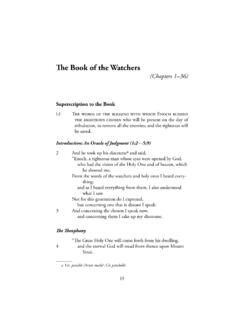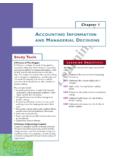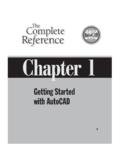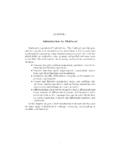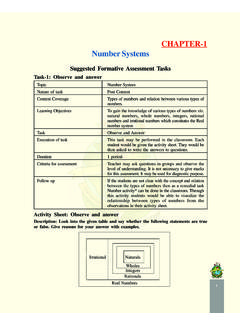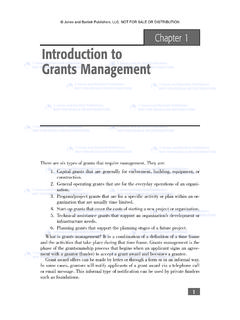Transcription of Overview of the Research Process - Jones & …
1 1 Overview of the Research ProcessLearning ObjectivesBy the end of this chapter the reader will be able to: Explain the steps in the Research Process . Describe the basic components of each step. Use the steps as an organizing mechanism for a Research OutLineI. IntroductionII. Definition of ResearchIII. Research ProcessIV. ConclusionScientific Research consists of seeing what everyone else has seen, but thinking what no one else has thought. Unknownchapter 106/07/12 12:11 AMi n t rO d u c t iO nThe main purpose of this chapter is to provide an Overview of the Research pro-cess. Many students quiver at the thought of conducting Research , but, in reality, each of us conducts Research projects in our everyday lives. For example, buy-ing a car involves the Research Process . The Process involves collecting data to decide between a new or used car, makes and models, and amenities; to consider budget limitations, dealer locations, their inventory, and prices; and so on.
2 Data are collected and analyzed to answer the question: What type of car best meets my needs and budget, and where is the best place to buy it? This is the Research e f i n i t iO n O f r e s e a r c hResearch is a systematic Process based on the scientific method that facilitates the identification of relationships and determination of differences in order to answer a question. The scientific method is a Process that uses an organized struc-ture to formulate questions and determine answers in a Research project. The key steps of scientific method are:1. Generate a hypothesis or ask a Research question. Research ideas usually start with a vague understanding of some problem. This understanding is usu-ally based on one s readings, observations, or other experiences in day- to-day life. In this step, the researcher usually refines the Research question or hypothesis so that it is focused and Observation or data collection.
3 The types of data and methods to collect them are determined by the Research question. Methods of data collec-tion include surveys, questionnaires, anthropometrics, observations, and so Testing the hypothesis through data analysis. This step involves analyzing the data to draw conclusions to support/refute the hypothesis or answer the Research Conclusions. Results of the analysis are interpreted vis- -vis the hypothesis or Research Compare the results to previous established theory. The findings from the Research are compared to the established theory to determine whether or not they fit or support the Ch a p t e r 1 Ov e r v i e w O f t h e re s e a rC h pr O Ce s 206/07/12 12:11 AMr e s e a r c h p r O c e s sRegardless of the area of Research or choice of methodology, the Research Process involves similar activities. The Process is an expression of the basic scientific method using the following steps: statement of the problem, generating a hypothesis, review of relevant studies, creating measures, choosing the sample, collecting data, analyz-ing data, and reporting results.
4 Figure 1 1 illustrates the Research 1 1 Illustration of the Research ProcessStatement of Problem(specify and justify a problem)HypothesisorFormulating a Research Question(precise testable statements/questions of the Research problem)Review of Literature(collection and summary of prior relevant studies)Measurements(operationalization of concepts)Sample Selection(group of people from which data will be collected)Data Analysis(using statistical techniques to summarize and interpret the findings) re s e a rC h pr O Ce s s 306/07/12 12:11 AMStatement of the ProblemThe first step in Research is pinpointing the topic of interest. Researchers usually start out with a vague idea of some problem and then slowly try to refine this idea into a concise statement. They review studies relevant to this topic to further illuminate the problem and refine the Research question. A strong problem statement is one sup-ported by a thorough review of relevant study results and a strong rationale or justi-fication for performing the study.
5 How will this study advance the field of interest?Generating a Hypothesis/Formulating a Research QuestionHypotheses and Research questions are precise statements or questions of the Research problems. A hypothesis is a prediction of what is expected to occur, or a relationship expected between concepts of interest. The hypothesis is typically tested with some form of experiment. Not all studies test hypotheses. Some ask more general ques-tions about the problem of interest. The focus can be largely of the Literature: Relevant StudiesA thorough search of literature is an important component of the Research pro-cess. The review involves the collection and summary of prior studies that are rel-evant to the hypothesis or Research question. This Process assesses what is already known about the problem and refines Research questions for extending knowl-edge in this field. The important focus should be the determination of what this study will add to what is already known.
6 The review can also provide ideas of what methods and instruments can be used to collect the are an important component of Research . Individuals vary in their interpretations of particular terms or concepts. For example, height = 60 could mean 60 inches, or 60 centimeters. Hence, key terms in the problem statement should be defined clearly. To follow the example of height, the researcher should indicate that height is measured in centimeters. This Process of definition is called operationalization: The concept in the researcher s head is translated into something that can be observed, measured, and understood by the study involves human subjects, then sample means a group of people from which data will be collected (subjects of the study). If the study is analyzing sec-ondary data collected by another investigator, then sample refers to the data sets. 4 Ch a p t e r 1 Ov e r v i e w O f t h e re s e a rC h pr O Ce s 406/07/12 12:11 AMUsually the sample is a group of people representing a target population, and the population is the larger group to whom the results are to be generalized.
7 Types of Research bias or systematic errors can be avoided with precise definitions of the target population and rigorous sampling are tools that collect and measure data. The selection of the tool depends on the focus and type of Research study (case study, observational study, cohort, and so on) being conducted. Each tool that will be used to collect data should be as precise (reliable) as possible and measure the intended concept (validity).Data AnalysisThis step in the Process involves the use of statistical techniques to summarize and interpret relevant Research results. Basic descriptive statistics ( , measure of incidence and prevalence, central tendency, dispersion) are part of every quanti-tative Research study. Inferential statistics are used in studies that test hypotheses. The main objective of data analysis is to answer the Research questions or test the hypothesis. Based on analysis results, conclusions are drawn and interpreted in the context of previous On cL u s iO nThis chapter illustrates Research as a Process of generating questions, selecting sam-ples, and measuring, collecting, and analyzing data to answer questions.
8 Commonly used terms in Research ( , statement of the problem, hypothesis, review of litera-ture, and so on) are introduced in this chapter . The information presented in this text is comprehensive, but not particularly detailed. Readers are encouraged to con-sult other sources for more details about specific procedures in the Research u rt h e r r e a d i n gChatburn, R. L. (2011). Handbook for health care Research (2nd ed.). Sudbury, MA: Jones & Bartlett , V. L. P., & Creswell, J. W. (2010). Understanding Research : A consumer s guide. Upper Saddle River, NJ: Pearson , C. J., Hardman, M. L., & Hosp, J. L. (2008). Designing and conducting Research in education. Thousand Oaks, CA: Sage , J. H. (2008). Educational Research : fundamentals for the consumer (5th ed.). Boston: Pearson Education. fu r t h e r re a d i n g 506/07/12 12:11 606/07/12 12:11 AM











